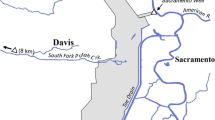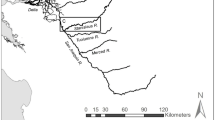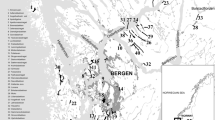Abstract
Sockeye salmon that spawn downstream of rearing lakes are an important example of the challenges faced by organisms with complex life histories requiring connectivity in aquatic habitat complexes. Specifically, newly emerged juvenile sockeye salmon must migrate upstream, against the flow of water, if they are to reach lake rearing habitat. Here, we examine the spatial and temporal dynamics of the water velocity landscape and juvenile sockeye salmon movement and condition at increasing distances downstream from the lake outlet of an important sockeye salmon system, the Babine Lake of British Columbia, one of Canada’s largest and most important sockeye salmon rearing lakes. The results of this study indicate that (i) there were seasonal and spatial patterns of water velocities that exceed the ability of juveniles to swim upstream to lake rearing habitat, (ii) higher water discharge was associated with more velocity barriers and potentially with less upstream movement of juveniles, and (iii) juveniles rearing in the lake obtained larger sizes (30% longer and 150% heavier) than those in downstream river habitats. Multiple processes that may be influencing these patterns could include more abundant food resources, lower metabolic demands, or size-selective immigration, emigration, or mortality among habitats. Years and seasons with high discharge may temporarily create one-way, downstream transport routes at lake outlets. Long-term changes in hydrology, perhaps driven by climate variability or land-use change, may control the degree to which lake outlets function as bidirectional travel corridors or one-way travel routes for young sockeye salmon.






Similar content being viewed by others
References
Adkison MD, Ward MB, Quinn TP (2014) Nest site preference and intrasexual competition in female sockeye salmon, Oncorhynchus nerka. Environ Biol Fish 97(4):385–399
Andrew FJ, Geen GH (1960) Sockeye and pink salmon production in relation to proposed dams on the Fraser River system. International Pacific Salmon Commission Bulletin XI: 259p
Armstrong JD (1997) Self-thinning in juvenile sea trout and other salmonid fishes revisited. J Anim Ecol 66:519–526
Beamish RJ, Mahnken C (2001) A critical size and period hypothesis to explain natural regulation of salmon abundance and the linkage to climate and climate change. Prog Oceanog 49:423–437
Beamish RJ, Mahnken C, Neville CM (2004) Evidence that reduced early marine growth is associated with lower marine survival of Coho Salmon. Trans Am Fish Soc 133:26–33
Buehler DM, Piersma T (2008) Travelling on a budget: predictions and ecological evidence for bottlenecks in the annual cycle of long-distance migrants. Phil Trans R Soc B 363:247–266
Brannon EL (1967) Genetic control of migrating behaviour of newly emerged sockeye salmon fry. International Pacific Salmon Commission Progress report no. 16. New Westminister, Canada
Brannon EL (1972) Mechanisms controlling migration of sockeye salmon fry. International Pacific Salmon fisheries commission. Bulletin XXI, New Westminister, Canada
Brett JR (1971) Energetic responses of salmon to temperature. A study of some thermal relations in the physiology and freshwater ecology of sockeye salmon (Oncorhynchus nerka). Am Zool 11:99–113
Brett JR, Hollands M, Alderdice DF (1958) The effect of temperature on the cruising speed of young sockeye and coho salmon. J Fish Res Board Can 15(4):587–605
British Columbia Ministry of the Environment (BCMOE) (2009) Manual of British Columbia Hydrometric Standards. Version 1.0. British Columbia Ministry of the Environment, Science and Information Branch, for the Resource Inventory Standards Committee. Victoria, British Columbia
Brown JA, Srivastava RK (1991) The biochemical characteristics and hatching performance of cultured and wild Atlantic salmon. Can J Zool 69(9):2436–2441
Burnham KP, Anderson DR (2002) Model selection and multimodel inference. Springer, New York
Burnham KP, Anderson DR (1998) Model selection and inference a practical information-theoretic approach. Springer, New York
Byrne JE (1971) Photoperiodic activity changes in juvenile sockeye salmon (Oncorhynchus nerka). Can J Zool 49:1155–1158
Claiborne AM, Fisher JP, Hayes SA, Emmett RL (2011) Size at release, size-selective mortality, and age of maturity of Willamette River hatchery yearling Chinook Salmon. Trans Am Fish Soc 140:1135–1144
Clarke WC (1967) Observations on the migration of sockeye salmon fry in the lower Babine River. Thesis, University of British Columbia
Clarke WC, Smith HD (1972) Observations on the migration of sockeye salmon fry (Oncorhynchus nerka) in the lower Babine River. J Fish Res Board Can 29(1):151–159
Cooperman MS, Markle DF, Terwilliger M, Simon DC (2009) A production estimate approach to analyze habitat and weather effects on recruitment of two endangered freshwater fish. Can J Fish Aquat Sci 67:28–41
Cox-Rogers S, Spilsted B (2012) Update assessment of sockeye salmon production from Babine Lake. British Columbia Can Tech Rep Fish Aquat Sci 2956:65p
Cushing DH (1990) Plankton production and year-class strength in fish populations: an update of the match/mismatch hypothesis. Adv Mar Biol 26:249–293
Department of Fisheries and Oceans Canada (DFO; Pacific Region) (2018) New Salmon Escapement Database System (NuSEDS). [internet] https://open.canada.ca/data/en/dataset/c48669a3-045b-400d-b730-48aafe8c5ee6
Dunning JB, Danielson BJ, Pulliam HR (1992) Ecological processes that affect populations in complex landscpaes. Oikos 65:169–175
Elliott JM (1989) The critical period concept and its relevance for population regulation in young sea trout. J Fish Biol 35:91–98
Einum S, Fleming IA (2000) Selection against late emergence and small offspring in Atlantic salmon (Salmo salar). Evolution 54:628–639
Fagan WF (2002) Connectivity, fragmentation and extinction risk in dendritic metapopulations. Ecology 83:3243–3249
Fausch KD, Torgersen CE, Baxter CV, Li HW (2002) Landscapes to riverscapes: bridging the gap between research and conservation of stream fishes. Bioscience 52:483–498
Foord V (2016) Climate patterns, trends, and projections for the Omineca, Skeena, and northeast natural resource regions, British Columbia. British Columbia Ministry of Forests, Lands and Natural Resource Operations, Omineca region. Prince George, British Columbia
Fry FEJ (1947) Effects of the environment on animal activity. Publ Ontario Fish Res Lab 68:1–62
Gibson ES, Fry FEJ (1954) The performance of lake trout, Salvelinus namaycush, at various levels of temperature and oxygen pressure. Can J Zool 32:252–260
Gilbert CH (1913) Age at maturity of the Pacific coast salmon of the genus Oncorhynchus. Ann Rep Brit Col Fish Dep 1912:57–70
Griffiths JS, Alderdice DF (1972) Effects of acclimation and acute temperature experience on the swimming speed of juvenile coho salmon. J Fish Res Board Can 29(3):251–264
Hartman GF, Northcote TG, Lindsey CC (1962) Comparison of inlet and outlet spawning runs of rainbow trout in loon Lake, British Columbia. J Fish Res Board Can 19:173–200
Heinimaa S, Heinimaa P (2004) Effect of the female size on egg quality and fecundity of the wild Atlantic salmon in the sub-arctic river Teno. Boreal Environ Res 9:55–62
Hermoso V, Ward DP, Kennard MJ (2012) Using water residency time to enhance spatio-temporal connectivity for conservation planning in seasonally dynamic freshwater ecosystems. J Appl Ecol 49:1028–1035
Hoar WS (1958) The evolution of migratory behaviour among juvenile salmon of the genus Oncorhynchus. J Fish Res Board Can 15(3):391–428
Jobling M (1985) Growth. In: Tytler P, Calow P (eds) Fish energetics: new perspectives. Croom & Helm, London, pp 213–230
Jorgensen B (1988) Metabolic costs of growth and maintenance in the toad, Bufo bufo. J Exp Biol 138:319–331
Killick SR (1949) A study of the embryonic development and fry behaviour of sockeye salmon in the South Thompson district. Thesis, University of British Columbia
Markle DF, Reithel SA, Crandall J, Wood T, Tyler TJ, Terwilliger M, Simon DC (2009) Larval fish transport and retention and the importance of location for juvenile fish recruitment in upper Klamath Lake, Oregon. Trans Am Fish Soc 138:328–347
McDonald J, Hume JM (1984) Babine Lake sockeye salmon (Oncorhynchus nerka) enhancement program: testing some major assumptions. Can J Fish Aquat Sci 41:70–92
McCart P (1967) Behaviour and ecology of sockeye salmon fry in the Babine River. J Fish Res Board Can 24(2):357–428
Moore JW, Gordon J, Carr-Harris C, Gottesfeld AS, Wilson SM, Russell JH (2016) Assessing estuaries as stopover habitats for juvenile Pacific salmon. Mar Ecol Prog Ser 559:201–215
Moss JH, Beauchamp DA, Cross AD, Myers KW, Farley EV, Murphy JM, Helle JH (2005) Evidence for size-selective mortality after the first summer of ocean growth by pink Salmon. Trans Am Fish Soc 134:1313–1322
Neary DG (2017) Forest management and water in the United States. In: Garcia-Chevesich PA, Neary DG, Scott DF, Benyon RG, Reyna T (eds) Forest management and the impact on water resources: a review of 13 countries. United Nations Educational, Scientific and Cultural Organization, Paris, pp 181–198
Pearcy WG (1992) Ocean ecology of the North Pacific salmonids. University of Washington Press, Seattle
Pinheiro J, Bates D, DebRoy S, Sarkar D, Team RC (2009) Nlme: linear and nonlinear mixed effects models. Available from http://cran.r-project.org/web/packages/nlme/index.html
R Development Core Team (2016) R: a language and environment for statistical computing. R Foundation for Statistical Computing, Vienna, Austria. Available from http://www.R-project.org
Raleigh RF (1971) Innate control of migrations of salmon and trout fry from natal gravels to rearing areas. Ecology 52(2):291–297
Schlosser IJ (1995) Critical landscape attributes that influence fish population dynamics in headwater streams. Hydrobiologia 303:71–81
Semko RS (1954) The stocks of West Kamchatka salmon and their commercial utilization. Izvestiia TINRO 41:3-109. [in Russian; English translation: fish res board can translation series no. 288, 1960]
Skoglund H, Einum S, Forseth T, Barlaup BJ (2011) Phenotypic plasticity in physiological status at emergence from nests as a response to temperature in Atlantic salmon (Salmo salar). Can J Fish Aquat Sci 68:1470–1479
Sogard SM (1997) Size-selective mortality in the juvenile stage of teleost fishes: a review. J Am Stat Assoc 99:262–278
Strayer DL, Findlay SEG (2010) Ecology of freshwater shore zones. Aquat Sci 72:127–163
Thompson JN, Beachamp DA (2014) Size-selective mortality of steelhead during freshwater and marine life stages related to freshwater growth in the Skagit River, Washington. Trans Am Fish Soc 143:910–925
Underwood AJ, Fairweather PG (1989) Supply side ecology and benthic marine ecology. Trends Ecol Evol 4:16–20
West CJ, Larkin PA (1987) Evidence for size-selective mortality of juvenile sockeye salmon (Oncorhynchus nerka) in Babine Lake, British Columbia. Can J Fish Aquat Sci 44:712–721
West CJ, Mason JC (1987) Evaluation of sockeye salmon (Oncorhynchus nerka) production from Babine Lake Development project. In: Smith HD, Margolis L, Wood CC (eds) Sockeye salmon (Oncorhynchus nerka) population biology and management, Can spec pub fish Aquat Sci, vol 96, pp 176–190
Wiens JA (2002) Riverine landscapes: taking landscape ecology into the water. Freshw Biol 47:501–515
Wood CC, Rutherford D, Bailey D, Jakubowski M (1998) Assessment of sockeye salmon production in Babine Lake, British Columbia with forecast for 1998. Can Tech Rep Fish Aquat Sci 2241:50p
Zabel RW, Achord S (2004) Relating size of juveniles to survival within and among populations of Chinook Salmon. Ecology 85:795–806
Zuur AF (2009) Mixed effects models and extensions in ecology with R. Springer, New York
Acknowledgements
This research is part of a collaboration between Lake Babine Nation Fisheries Department and Simon Fraser University. The authors would like to thank Angel Marlowe, Fern Marlowe, Christie West, Clifford Aslin, and Peter Greene for field and logistical support. We would like to thank David Patterson and his research group, of Fisheries and Oceans Canada, for supporting laboratory analyses. We would like to thank the Lake Babine Nation Fisheries Department, Tides Canada, and the Pacific Salmon Foundation for funding this work. We also thank the Skeena Watershed Conservation Coalition, the Skeena Wild Conservation Trust, the Liber Ero Foundation, Billy Labonte and Babine Norlakes, the Salmon Watersheds Lab, and the Earth to Ocean Research Group for making this research possible.
Author information
Authors and Affiliations
Corresponding author
Ethics declarations
Compliance with ethical standards
All applicable international, national, and/or institutional guidelines for the care and use of animals were followed. All procedures performed in studies involving animals were in accordance with the ethical standards of the Canadian Council on Animal Care and the Simon Fraser University Animal Care Committee (protocols 1129B-14, 1158B-11, and 1158B-11-23).
Additional information
Publisher’s note
Springer Nature remains neutral with regard to jurisdictional claims in published maps and institutional affiliations.
Supplementary Information
Fig. S1
Babine River discharge on the average observed peak emergence date for Lower Babine River sockeye salmon (Oncorhynchus nerka). Data were recorded at the Water Survey of Canada station, located on the west bank, approximately 25 m below the enumeration weir. Note: In 1964 and 1965, downstream travel peak was observed on June 15th. In 1966, the peak was observed June 7th. In 2015 and 2016 the peak was observed between May 29th-June 1st (PNG 173 kb)
Fig. S2
Historical spawn timing for Lower Babine River sockeye salmon (Oncorhynchus nerka). Points without error bars are precise date recordings, error bars added when only week or month are recorded in historical archives (PNG 121 kb)
ESM 3
(DOCX 28 kb)
Rights and permissions
About this article
Cite this article
Sweeney-Bergen, E.K., Macintyre, D. & Moore, J.W. Ontogenetic habitat shifts and vulnerability: lake-outlet-spawning sockeye salmon (Oncorhynchus nerka) sensitivity to habitat connectivity and hydrologic change. Environ Biol Fish 104, 383–399 (2021). https://doi.org/10.1007/s10641-021-01071-1
Received:
Accepted:
Published:
Issue Date:
DOI: https://doi.org/10.1007/s10641-021-01071-1




